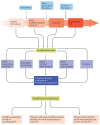The RA-MAP Consortium: a working model for academia-industry collaboration
- PMID: 29213124
- PMCID: PMC6711406
- DOI: 10.1038/nrrheum.2017.200
The RA-MAP Consortium: a working model for academia-industry collaboration
Erratum in
-
Corrigendum: The RA-MAP Consortium: a working model for academia-industry collaboration.Nat Rev Rheumatol. 2018 Jan 24;14(2):119. doi: 10.1038/nrrheum.2018.6. Nat Rev Rheumatol. 2018. PMID: 29362468
Abstract
Collaboration can be challenging; nevertheless, the emerging successes of large, multi-partner, multi-national cooperatives and research networks in the biomedical sector have sustained the appetite of academics and industry partners for developing and fostering new research consortia. This model has percolated down to national funding agencies across the globe, leading to funding for projects that aim to realise the true potential of genomic medicine in the 21st century and to reap the rewards of 'big data'. In this Perspectives article, the experiences of the RA-MAP consortium, a group of more than 140 individuals affiliated with 21 academic and industry organizations that are focused on making genomic medicine in rheumatoid arthritis a reality are described. The challenges of multi-partner collaboration in the UK are highlighted and wide-ranging solutions are offered that might benefit large research consortia around the world.
Conflict of interest statement
A.P.C. declares that he has acted as a consultant for or received honoraria from BMS, Eisai, GSK, Janssen and Roche. For a full list of competing interests for all co-authors, see Supplementary information S6 (table).
Figures


